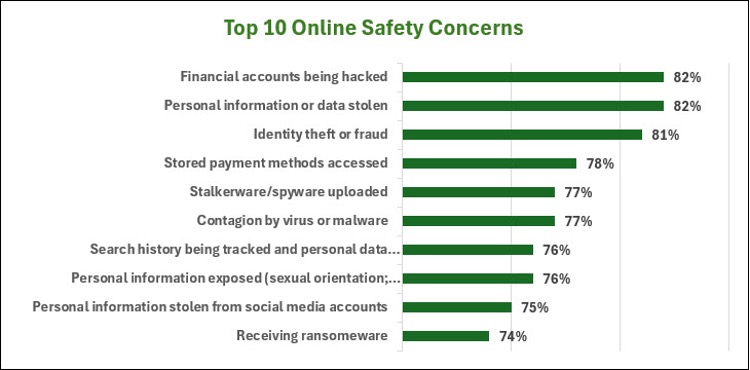Understanding digital stress across America
Editor's note: Terry Vavra and Doug Pruden are partners at Customer Experience Partners LLC. They can be reached at terry@terryvavra.com and pruden@customerexperiencepartners.com, respectively. This is an edited version of an article that originally appeared here.
Privacy is a big issue. While we’ve come to accept that our privacy is under attack, it’s important to note that the threats do not only come from the “outside” (hackers and cyber crooks). Many Americans are creating their own attacks on privacy through the use of “stalkerware” that is intentionally added to the devices of loved ones and even acquaintances.
To better understand this problem and its psychological impact, Malwarebytes, a cyber protection agency, surveyed 1,000 Americans between the ages of 13 and 77 – questioning them about their worries, their internet activities and the measures they take to stay safe. The results were published in an insight-provoking article (titled, "Everyone's afraid of the internet") that digs into the privacy worries Americans suffer from most as a consequence of their online activities. The results of the survey are alarming.
American consumers' actions do not match stated worries
The actions of Americans regarding the internet are inconsistent with their many worries and fears – in fact, they acknowledge the risks yet continue to lead lives highly visible on the internet.
Malwarebytes’ survey confirms Americans' anxiety related to their online activities. Almost 80% said they were “very concerned” about the risks of being online. Only half felt confident in their ability to keep themselves safe. Financial and data breaches were respondents’ top concerns.
 A large majority fear cyber threats due to their own lived experiences. Seventy percent of respondents reported having experienced an actual cybersecurity breach, with the most frequently mentioned being online scams, financial breaches and contamination by virus or malware. About 1 in 10 respondents reported serious, personal violations like their location being accessed, the uninvited installation of stalkerware/spyware and invasion by ransomware.
A large majority fear cyber threats due to their own lived experiences. Seventy percent of respondents reported having experienced an actual cybersecurity breach, with the most frequently mentioned being online scams, financial breaches and contamination by virus or malware. About 1 in 10 respondents reported serious, personal violations like their location being accessed, the uninvited installation of stalkerware/spyware and invasion by ransomware.
Despite their worries and actual experiences, respondents admitted to engaging in a host of risky activities:
- 65% admitted using the same password across multiple accounts.
- 59% reported sharing their birthdate on social media.
- 54% had interacted with strangers online.
- 45% admitted to taking quizzes that solicited personal information.
Use of cybersecurity tools
Despite their serious concerns over online threats, respondents paradoxically professed little use of cybersecurity tools, further emphasizing the disconnect between fear of theft and active prevention.
- Only 35% reported the use of antivirus software.
- Only 27% reported using a VPN.
- Less than a quarter (24%) reported the use of multifactor authentication.
- Only 15% reported using a password manager.
This seeming naivete underscores the need to educate consumers on how to safely coexist with the internet.
Online monitoring
So far, we’ve only discussed the consequences of personal actions involved in using online activities. Online monitoring raises an additional concern.
Seventy-one percent of respondents reported monitoring their children online. GPS tracking, reading texts, checking search histories and using monitoring apps have become accepted actions for many families. Of those parents monitoring their children, 51% reported that they do so without the child’s knowledge or assent.
- 71% of parents reported they monitor their children online.
- 53% reported looking through their children’s texts, e-mails and DMs.
- 53% have looked at their child’s search history.
- 48% have tracked their child’s location using apps and tools.
- 40% have installed monitoring software/apps on a child’s devices.
Two-thirds of participating parents admitted to also monitoring their children offline (searching personal possessions; reading personal journals and letters; and physically following children to observe their actions).
But it’s not just children who are being monitored, it’s also spouses and partners monitoring one another, generally without the knowledge of the observed individual. Sixty-two percent of the respondents admitted to monitoring their spouse/partner online! While monitoring the actions/location of one’s child can be defended, monitoring one’s spouse/partner is considerably different and without excuse. Respondents generally agreed with this observation, and only 38% agreed that it’s OK to monitor your spouse/partner. Invasion of privacy concerns are present in both cases (children and spouses) but to differing degrees considering the underlying motives for doing so.
The future of cybersecurity amid rising privacy concerns
While the fears of online privacy violations will ultimately make collecting information from customers (to expand the power of “learning customer bases”) more difficult, customers’ professed avoidance of strict cybersecurity disciplines lessens the immediate impact. However, privacy initiatives like the California’s Consumer Privacy Act (CCPA) and Europe’s General Data Protection Regulation (GDPR) will surely foster some ultimate governmental involvement in cybersecurity.
Astute marketers who want both to improve their understanding of their customer bases and be prepared for more restrictions on their initiatives need to begin appraising their customers of how the information they collect will be protected and used to improve the customer experience.
